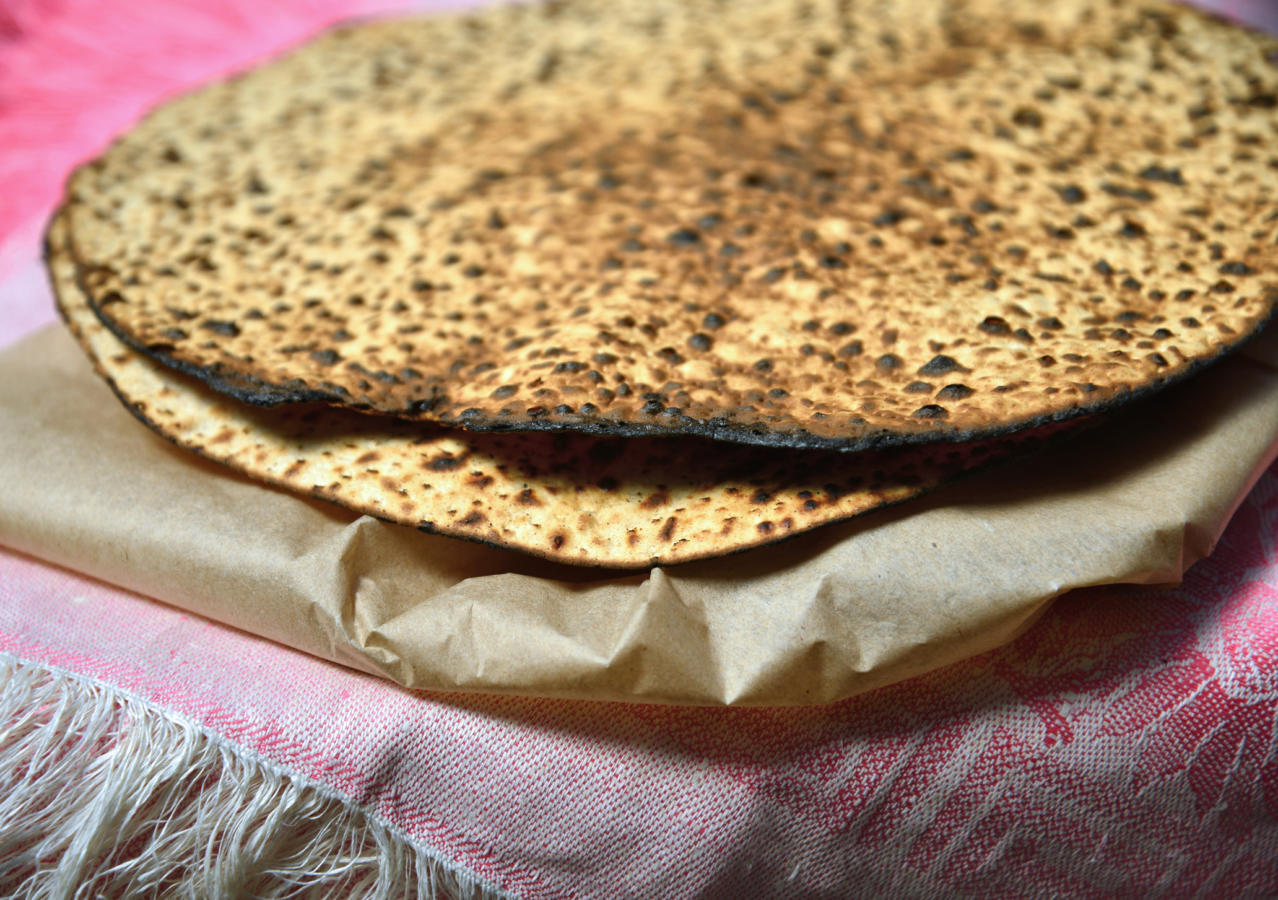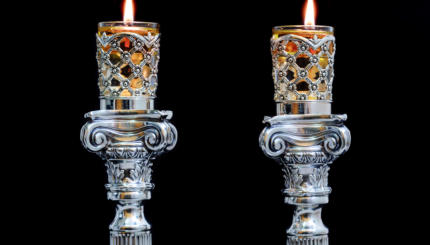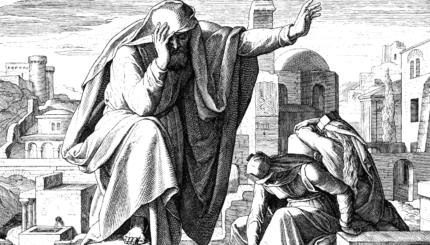Hag HaPesach (the festival of the paschal lamb)–the sacrificial rite of the paschal lamb and its consumption–was the main feature of the ancient Passover ceremony that ushered in the holiday. This unique ritual included the slaughtering of the lamb on the afternoon of the 14th of Nisan (Leviticus 23:5). This was an exception to the general rule that all festival offerings are to be sacrificed on the day of the festival.
Furthermore, the lambs were slaughtered by the Israelites, privately by each family, and the priests poured the blood on the base of the altar. All other offerings were generally slaughtered by the priests. When the [Second] Temple was destroyed [in 70 CE], all sacrifice eventually ceased, and only the Samaritans continued to bring the offering in their own community. To this day, they slaughter a lamb at sunset, read Exodus Chapter 12, and eat the Passover meal after midnight together with unleavened bread (matzah) and bitter herbs.
The explanation for the uniqueness of the Passover sacrificial rite may be found in its commemorative aspects. The Bible repeatedly emphasized this facet of Passover, “And this day shall be for you a memorial…” (Exodus 12:14); “And Moses said to the people: remember this day in which you come out from Egypt, out of the house of bondage…” (Exodus 13:3); “You shall remember what Adonai your God did to Pharaoh…” (Deuteronomy 7:18); “that you may remember the day when you come out of the land of Egypt all the days of your life” (Deuteronomy 16:3). These verses are a clear indication that the general function of the Passover pageantry was to serve as a constant reminder to the Israelites of their struggle against slavery and their wondrous deliverance from Egyptian bondage.
The festival of the paschal lamb was ushered in on the evening of the 14th of Nisan. On that night, the Israelites were ordered to eat the paschal lamb, and several restrictive rules were added to this feast. “And they shall eat the flesh in that night, roasted with fire; with unleavened bread and bitter herbs they shall eat it” (Exodus12:8). They were not to eat it rare or boiled in water (Exodus 12:9). They were not to leave the meat over past the conclusion of the night (Exodus 12:10). They were not to break any of the bones of the lamb (Exodus 12:46). No alien sojourner, hired servant, or uncircumcised person may eat the meat of the paschal lamb (Exodus 12:43-45). And finally, the feast was to be held in one house, and no part of the meat was to be taken outside the house (Exodus 12:46).
A bevy of explanations has been offered for these various biblical rites attached to the paschal lamb and its sacrifice. Some scholars regarded the injunction to have the lamb roasted as a distinction from ancient pagan spring festival rites, when meat was eaten either uncooked or half-broiled. Non-Israelites and uncircumcised ones were precluded from participating in the feast of the paschal lamb because the occasion was one of reaffirming God’s covenant with the Israelites. The symbolism of the eating of the paschal lamb with the matzah and bitter herbs was a reminder to the Israelites of an enslaved past.
Interestingly, the smearing of blood on the doorposts did not become a part of the Passover pageantry. Since all paschal lambs were slaughtered in Jerusalem once the Temple was built, the Israelites would have been too far from their homes to smear blood on their doorposts.
Hag HaMatzot: The Feast of Unleavened Bread
The feast of unleavened bread was an agricultural festival that celebrated the beginning of the grain harvest when an offering of the first fruits was made and unleavened bread eaten. This feast coincided with the feast of the paschal lamb. The principal feature of the feast of unleavened bread is stated in the Bible: “Seven days you shall eat unleavened bread.” The unleavened bread commemorated the speed with which the Jews had to leave Egypt and thus became symbolic of Israelite redemption.
According to Rabbi Abraham Bloch, the main distinction between the Hag HaPesach and Hag HaMatzot lies in the historical area that each seeks to reflect. The Hag HaPesach reenacts the events of the 14th of Nisan (the pre-exodus period), and the Hag HaMatzot marks the actual departure from Egypt of the Israelites, which was concluded with the crossing of the Red Sea (exodus period). Both are component parts of the same festival, the festival of Passover.
Other Celebrations of Passover in the Bible
The observance of the first Passover in Palestine is mentioned in the Book of Joshua(5:10-11). Here it is said that the Israelites, led by Joshua, successor to Moses, kept the feast at Gilgal. This reference to Passover stresses the classical message of the festival–the humble origin of the Jewish people, the covenant with Abraham, God’s intervention in Egypt, the fulfillment of God’s promises, and the reaffirmation of faith.
For about three centuries after the death of Joshua, anarchical conditions loomed as a result of lack of leadership and constant harassment by hostile neighbors. During this time, Passover played little or no role in the national life of the people.
The appearance of Samuel in the 11th century BCE at the end of the period of the Judges brought about a religious revival. Passover again assumed its prime function as a religious festival.
About 400 years after Samuel, during the religious revival in the reign of King Josiah (637-607 BCE), reference was made to a Passover celebration with this statement:
The king commanded all the people saying, “Keep the Passover unto the Lord your God, as it is written in this book of the covenant.” For there was not kept such a Passover from the days of the judges that judged Israel, nor in all the days of the kings of Israel, nor of the kings of Judah; but in the eighteenth year of King Josiah was this Passover kept to the Lord in Jerusalem [II Kings 23:21-23].
The religious revival that began with Samuel continued through the reign of King David and reached its zenith under King Solomon with the construction of the [First] Temple in Jerusalem [ca. 960 BCE].
Passover in Temple Times
The construction of the magnificent Temple in Jerusalemlent new significance to the festival of Passover. A Talmudic passage (dating from the period of the Second Temple [515 BCE – 70 CE]) describes the Temple ritual on the 14th of Nisan. The description reflects the procedure in the time of the First Temple:
The paschal lamb was slaughtered in three groups… when the first group entered and the Temple court was filled, the gates of the Temple were closed. A tekiah, teruah, and again a tekiah were then blown on the shofar. The priests stood in rows, and in their hands were basins of silver and basins of gold. … An Israelite slaughtered his offering and the priests caught the blood. The priest passed the basin to his fellow priest, and he to his fellow, each receiving a full basin and giving back an empty one. The priest nearest to the altar tossed the blood against the base of the altar. While this ritual was performed the Levites sang the Hallel [Talmud Pesachim 64a].
There are several biblical references indicating that this procedure was also followed in Solomon’s Temple.
Following the rededication of the Temple by King Hezekiah, the priests are described as tossing the blood of the paschal lamb upon the altar (II Chronicles 30:16). The Levites and priests are also described as having “praised God day by day [Hallel], singing with loud instruments to God” (11 Chronicles 30:21).
In the year 932 BCE, Jeroboam, the first king of Israel, reintroduced idolatry. Paganism spread throughout Israel and Judea and reduced the number of Jews who made the annual pilgrimage to Jerusalem. In the year 720 BCE, King Hezekiah set out to restore the ancient covenant. In his address to the priests and Levites he said, “Now it is in my heart to make a covenant with the God of Israel…” (II Chronicles 29:10). The renewal of the covenant was to be formalized by a national celebration of Passover, with the paschal lamb ritual as the highlight of the celebration. King Josiah, in 637 BCE, next spearheaded a Jewish spiritual revival with the accidental discovery of a Torah scroll in the course of repair work to the Jerusalem Temple. A public celebration of Passover with the slaughtering of paschal lambs was the climax of the festivities.
When the Second Temple was completed in 515 BCE, the entire biblical ritual of Passover was restored. Priests and Levites slaughtered the paschal offerings for the returning Jews of the Babylonian captivity. The new community “kept the festival of Matzot seven days with joy, for God had made them joyful…” (Ezra 6:22). The historian Josephus records contemporary Passover celebrations in which he estimates that the participants who gathered in Jerusalem to perform the sacrifice in the year 65 CE were “not less than three million” (Josephus, Wars, 2:280). The Talmud (Pesachim 64b) similarly records:
King Agrippa once wished to take a census of the hosts of Israel. He said to the high priest, “Cast your eyes on the Passover offerings.” He took a kidney from each, and 600,000 pairs of kidneys were found there, twice as many as those who departed from Egypt, excluding those who were unclean and those who were on a distant journey, and there was not a single paschal lamb for which more than ten people had not registered; and they called it: “The Passover of the dense throngs.”
With the destruction of the Temple, the offering of the paschal came to an end.
Excerpted with permission from Every Person’s Guide to Passover (Jason Aronson, Inc).
Adonai
Pronounced: ah-doe-NYE, Origin: Hebrew, a name for God.
Nisan
Pronounced: nee-SAHN, Origin: Hebrew, Jewish month, usually coinciding with March-April.
Talmud
Pronounced: TALL-mud, Origin: Hebrew, the set of teachings and commentaries on the Torah that form the basis for Jewish law. Comprised of the Mishnah and the Gemara, it contains the opinions of thousands of rabbis from different periods in Jewish history.
Torah
Pronunced: TORE-uh, Origin: Hebrew, the Five Books of Moses.



